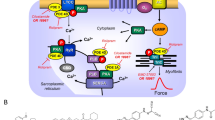Summary
The enhanced arrhythmogenic risk of combined treatment with cardiac glycosides and beta-sympathomimetics is referred in some textbooks, but only a few detailed studies on in vivo models are available. We therefore investigated this problem in conscious dogs in an intraindividual study. We determined the dose of acetylstrophanthidin (intravenous infusion of 5 mcg/kg per min), which provoked ventricular premature beats with and without concomitant treatment with the partial betaagonistic compounds doxaminol (3 mg/kg p.o.), prenalterol (0.4 or 1.0 mg/kg p.o) or isoprenaline (0.31±0.100 mcg/kg per min). In some dogs a coronary artery was narrowed in order to reduce the coronary blood supply. The arrhythmogenic dose of acetylstrophanthidin was nearly the same in all the groups investigated (range from 52.1±5.66 to 59.9±3.23 mcg/kg). Whereas the arrhythmogenic dose of acetylstrophanthidin was unchanged by beta-sympathomimetics, the combination of the glycoside and each of the beta-agonistic drugs increased the contractile force more than did either single compound.
We therefore conclude that the arrhythmogenic risk of the combination of glycosides and betasympathomimetics may be — at least in experimental models — less than has been suggested in the past.
Similar content being viewed by others
References
Ariniego R, Waagstein F, Mombay, B, Hjalmarson A (1979) Haemodynamic effects of a new beta1-receptor agonist in acute myocardial infarction. Br. Heart J 42:139–146
Becker DJ, Nonkin PM, Bennett LD, Kimball SG, Sternberg MS, Wassermann F (1962) Effect of isoproterenol, in digitalis cardiotoxicity. Am J Cardiol 10:242–247
Chapple DJ, Hughes R, Johnson BF (1976) The relationship between cardiotoxicity and plasma digoxin concentration in conscious dogs. Br J Pharmacol 57:23–27
Ek L, Björkman J-A, Carlsson E (1979) Cardiac inotropic effects of prenalterol and ouabain in conscious dogs. Acta Physiol Scand 473:64
Greeff K, Köhler E, Forthmüller HW, Schmidt R (1973) Wechselwirkung zwischen herzwirksamen Glykosiden und Beta-Sympathomimetika. Arzneim Forsch 23:759–764
Hansten PD (1979) Digitalis drug interactions. In: Drug Interactions. Lea & Febiger, Philadelphia, 192–199
Harris AS (1950) Delayed development of ventricular ectropic, rhythms following experimental coronary occlusion. Circulation 1:1318–1327
Hood WB, McCarthy B, Lown B (1967) Myocardial infarction following coronary ligation in dogs. Circ Res 21:191–199
Johnson BF (1980) Drug interactions involving digitalis glycosides. In: Petric JC (ed) Cardiovascular and respiratory disease therapy. Elsevier, Amsterdam New York Oxford, 7–20
Kumar R, Hood WB, Gilmour DP, Abelmann WH (1972) Effects of acetylstrophanthidin on cardiovascular function in intact conscious, dogs. J Pharmacol Exp Ther 180:24–30
Kurz H (1981) Positiv inotrop wirkende Stoffe. In: Ammon HPT (ed.) Arzneimittelneben- und-wechselwirkungen. Wissenschaftl Verlagsgesellschaft Stuttgart, p 282–287
Lown B, Levine SA (1954) Current concepts in digitalis therapy. N Engl J Med 250:866–874
Lown B, Wolf M (1971) Approaches to sudden death from coronary heart disease. Circulation 44:130–142
Lucchesi BR, Shivak R (1964) Effect of quinidine and procaine amide upon acetylstrophanthidin cardiotoxicity. J Pharmacol Exp Ther 143:366–373
Lyon AF, de Graff AC (1966) Reappraisal of Digitalis, Part X Treatment of digitalis toxicity. Am Heart J 73:835–837
Maninen V, Nyberg L (1981) Interaction between cardiac glycosides and other substances in the body. In: Greeff K (ed) Cardiac glycosides. Part II. Springer, Berlin Heidelberg New York, 299–336
Mattson H, Hedberg A, Carlsson E (1982) Basic pharmacological properties of prenalterol. Acta Med Scand Suppl 659:6–37
Marlow HF, Wardleworth AG, Booth LM (1982) The hemodynamic effect of oral doses of ICI 118.587, a beta adrenoceptor partial agonist, in healthy volunteers. Br J Clin Pharmacol 13:269–270
Ogden PC, Selzer A, Cohn KE (1969) The relationship between the inotropic and chronotropic effects of digitalis: the modulation of these effects by autonomic influences. Am Heart J 77:628–635
Raper C, Wale J (1969) Cardiac arrhythmias produced by interaction of ouabain and beta-receptor stimulation. Eur J Pharmacol 6:223–234
Roberts J, Jto R, Reilly J (1963) Influence of reserpine and beta-TM 10 on digitalis induced arrhythmia. Circ Res 13:149–158
Selden R, Klein MD, Smith TW (1973) Plasma concentration and urinary excretion kinetics of acetylstrophanthidin. Circulation 47:744–751
Sonnenblick EH, Frishman WH, le Jemtel TH (1979) Dobutamine: a new synthetic cardioactive sympathetic amine. N Engl J Med 300:17–22
Sponer G, Heeg E, Bartsch W, Strein K, Müller-Beckmann B (1982) Die β-sympathomimetischen und β-sympatholytischen Eigenschaften von Doxaminol (BM 10.188) in vivo und in vitro. Z Kardiol 71:171 P 110
Sponer G, Schaumann W, Müller-Beckmann B (1982) The cardiac effects of doxaminol, digoxin and their combinations in comparison with epinephrine plus digoxin in cats with acute heart failure. Naunyn-Schmiedebergs Arch Pharmacol:R 44, 174
Sponer G, Strein K, Bartsch W, Müller-Beckmann B (1982) Untersuchungen zur cardiotonen Wirkung von Doxaminol (BM 10, 188) an Katzen, Ratten und Hunden. Z Kardiol 71:171, P 109
Stroman F, Hempel R (1975) Über pharmkologische Wirkungen bei der kombinierten Anwendung von Oxyfedrin mit Beta-Acetyl-Digoxin. Arzneim Forsch 25:386–388
Williams JF, Boyd DL, Border JF (1968) Effects of acute hypoxia and hypercapnic acidosis on the development of acetylstrophanthidin-induced arrhythmias. J Clin Invest 47:1885–1895
Author information
Authors and Affiliations
Rights and permissions
About this article
Cite this article
Haass, M., Sponer, G. & Abshagen, U. Arrhythmogenic dose of acetylstrophanthidin unchanged by beta-sympathomimetics in conscious dogs. Basic Res Cardiol 79, 679–689 (1984). https://doi.org/10.1007/BF01908385
Received:
Issue Date:
DOI: https://doi.org/10.1007/BF01908385




